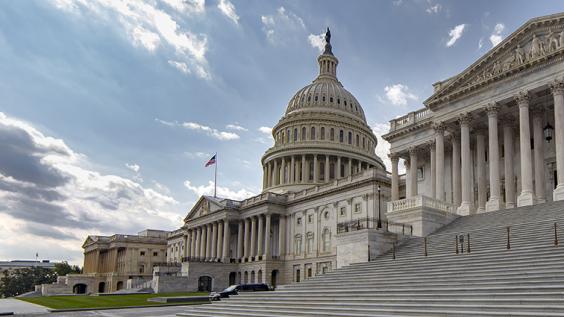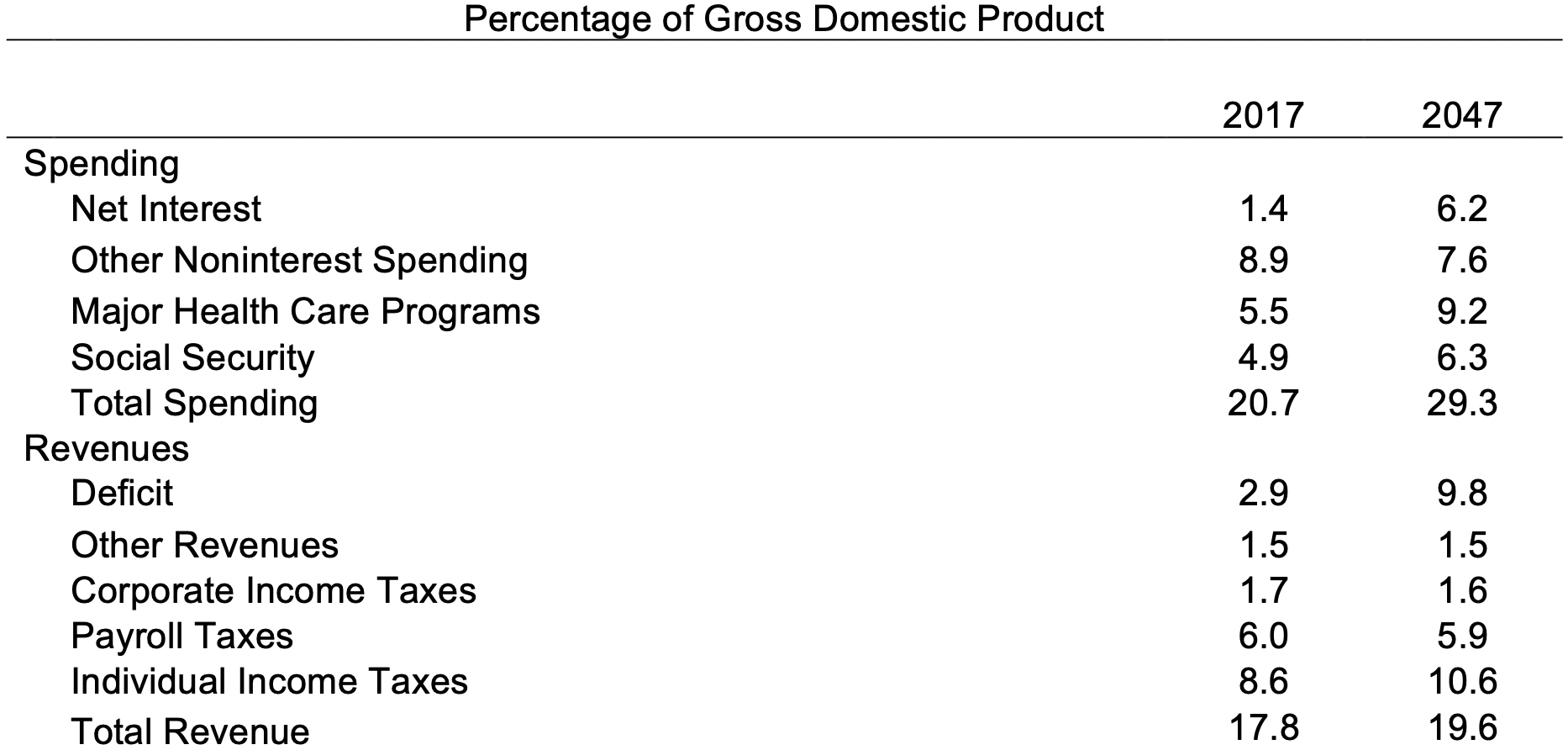The Economic and Fiscal Benefits of Pro-growth Policies

Table of Contents
Author(s)
This testimony was delivered before the U.S. House of Representatives Budget Committee on June 7, 2017.
Video of Diamond's Testimony
Written Statement
Chairwoman Black, Ranking Member Yarmuth, and Members of the Committee, it is an honor to present my views on the economic and fiscal benefits of pro-growth policies.
Growth is important in determining the future size of the economy and the standard of living. Small changes in growth can have a significant impact on the size of the economy. For example, an increase in the growth rate from 2.0 percent to 2.5 percent would increase the size of the economy by 28 percent in 10 years, and reduce the time required to double the size of the economy by seven years, from 35 to 28 years. Accordingly, policies that increase the growth rate of the economy by a small amount can have significant impacts in the long term.
Enacting pro-growth policies is particularly important at this time for two reasons. First, U.S. fiscal policy is on an unsustainable path, with deficits and debts projected to continue to grow dramatically as the baby boom generation ages and transitions from work to retirement, thus decreasing the ratio of the number of workers to retirees while increasing public expenditures on retirement and healthcare programs. The Congressional Budget Office (hereafter CBO, 2017) reports that retirement and healthcare expenditures are expected to increase faster than GDP because the population is aging (which accounts for 3.5 percent of the increase in expenditures) and the average price of health care services is increasing faster than GDP (which accounts for 2.9 percent of the increase in expenditures). Second, there is substantial uncertainty regarding the future growth rate of the American economy. One view is that continued innovation will spur productivity growth in the coming decades as new technologies lead to significant increases in output per person. However, another view is that the recent advances in technology have not led to significant and lasting increases in productivity, and that in addition the U.S. economy is facing a number of impediments that may reduce the growth rate of real GDP per person below the levels of 2.4 percent per year that characterized the period 1920–1970 or even the growth rate of 1.8 percent per year from 1970–2014 (Gordon, 2016). Gordon projects that from 2015–2040 the growth in real GDP per person could be as low as 0.8 percent per year. The major impediments to future growth rates include large and growing debts at the federal, state and local levels, demographic changes such as the population aging noted previously, the growth and accumulation of regulatory policy, and slower gains in educational achievement. In addition, rising inequality, changes in family structure and other social indicators, as well as the effects of globalization, including increased competition from abroad, may also dampen future growth rates.
The current path of U.S. fiscal policy is unsustainable. CBO (2017) projects that total spending will increase as a share of GDP from 20.7 percent in 2017 to 29.3 percent in 2047, and total revenue is projected to increase as a share of GDP from 17.8 percent in 2017 to 19.6 percent in 2047. The federal debt is projected to increase as a share of GDP from 77 percent in 2017 to 150 percent in 2047. As noted above, demographic changes are driving much of the increase in federal spending with the remaining increase related to rising interest payments on the national debt.
Table 1 — The Federal Budget Under the Extended Baseline

The obvious conclusion is that the projected expenditure increases in the United States are unsustainable and fiscal restraint is imperative. The United States must reduce the projected level of expenditures and reform its tax system to reduce economic distortions and maximize economic growth. Tax reform should include a focus on limiting government expenditures that occur through the tax system. Otherwise, the combination of rising a debt level and a relatively distortionary tax system will significantly hamper economic growth more so than has already occurred.
These developments have not gone unnoticed, as numerous proposals for fiscal and tax reform have emerged, with tax reforms ranging from base broadening, rate reducing reforms to consumption-based tax reforms. An outline of the first approach was put forward by the co-chairs of President Obama’s 2010 fiscal commission, Erskine Bowles and Alan Simpson. They issued a report, A Path Forward to Securing America’s Future, which included $2.5 trillion in deficit reduction, including a reform of both the corporate and individual income tax systems.
There is in particular a strong case for business tax reform. The last major reform was the Tax Reform Act of 1986. Since that time, however, many countries have reformed their tax structures, lowering statutory rates while removing tax preferences. As a result, the United States now has the highest statutory corporate tax rate in the industrialized world.
Proponents of corporate tax reform argue that high tax rates discourage investment and capital accumulation and thus reduce productivity and economic growth. In addition, the combination of a high statutory tax rate coupled with a wide variety of tax preferences distorts the allocation of investment across asset types and industries and reduces the productivity of the nation’s assets, while exacerbating the many inefficiencies of the corporate income tax, including distortions of business decisions regarding the method of finance and organizational form (corporate vs. non-corporate), and the mix of retentions, dividends paid, and share repurchases.
There is also widespread discontent with the individual income tax system. High individual tax rates coupled with a multitude of tax preferences distort decisions regarding labor supply, saving, and consumption; they also significantly complicate tax administration and compliance while encouraging tax avoidance and evasion. Moreover, many tax preferences are poorly designed. For example, the home mortgage interest deduction’s primary purpose is to encourage home ownership. It is poorly designed to achieve this goal, as it offers little or nothing to low- and middle-income individuals who do not itemize, have total deductions that are less than or roughly equal to the standard deduction, or are subject to relatively low marginal tax rates. Instead, the vast majority of the benefits of the home mortgage interest deduction accrue to high-income taxpayers, encouraging overconsumption of housing at the expense of investment in the rest of the economy.
Studies by the Organisation for Economic Co-operation and Development (2008), Viard and Diamond (2008), and the Joint Committee on Taxation (2005) show that the corporate tax is the most harmful tax instrument to economic growth, followed by individual income taxes. While tax reductions in the form of increased personal exemptions, deductions, and credits are likely to reduce long-run growth. Thus, policymakers should adopt a tax system characterized by low capital and labor income tax rates, and minimal tax expenditures.
In fact, serious consideration should be given to a more fundamental reform of the tax structure – adopting a consumption- rather than income-based tax. However, if consumption-based tax reform is not feasible, current personal income tax provisions that encourage saving should be maintained but simplified, and serious consideration should be given to reducing the burden of the corporate income tax on investment income.
Demographic changes are also a major impediment to economic growth in the future because the retirement of the baby boom generation will further reduce the labor force participation rate. Aaronson et al. (2014) find that about half of the change in the labor force participation rate since 2007 is related to an aging population. This effect will continue to dampen the economic growth rate over the next two decades.
Another important impediment to growth is the accumulation of government regulations. Excessive regulation of the U.S. economy is likely slowing growth and limiting risk taking. The regulatory burden affects a wide range of markets, including the market for prescription drugs, the labor market through licensing requirements and the implicit taxes in the Affordable Care Act, the energy market, the financial services sector, and many others. For example, Mulligan (2015) argues that the Affordable Care Act will reduce employment and hours worked by 3 percent and labor income and GDP by 2 percent. Dawson and Seater (2013) find that regulation added since 1949 is responsible for decreasing the size of the U.S. economy by 28 percent as of 2005. They argue that their results explain much of the decline in productivity growth in the 1970s. Haidar (2012) finds that “each business regulatory reform is associated with a 0.15 percent increase in growth rate of GDP.” Coffey, McLaughlin, Peretton (2016) find that since 1980 the cumulative effect of regulations reduced economic growth by 0.8 percent. While the exact cost of regulation in terms of reduced growth is uncertain, the growing number of regulations is almost certainly a hindrance to economic growth and a major reform of regulatory law is overdue.
The slowing growth in educational attainment is also likely to impede economic growth in the future relative to the past 50 years. Achieving the educational gains from that period will be nearly impossible. In addition, other factors such as rising inequality and break downs in family structure and social capital are likely to impede the growth of educational attainment. Reforming and re-organizing the education system is necessary to maximize future growth rates. Finally, increased competition from a continuing trend toward globalization (and to some extent immigration) will likely continue be a drag on the income growth of the lower- and middle-income cohorts in the United States. While both globalization and immigration can have positive growth impacts there are also winners and losers from the disruptions they cause to the U.S. economy.
Policymakers should focus on reducing the government debt through spending restraint, reforming and reducing entitlement programs, reprioritizing other expenditure items to fit in a sustainable budget, and minimizing marginal tax rates while reforming expenditures that occur through the tax system.
References
Aaronson, Stephanie, Tomaz Cajner, Bruce Fallick, Felix Galbis-Reig, Christopher Smith, and William Wascher, 2013. “Labor Force Participation: Recent Developments and Future Prospects,” Federal Reserve Bank of Cleveland, Working Paper no. 14-10.
Bowles, Erskine and Alan Simpson, 2013. “A Bipartisan Path Forward to Securing America’s Future,” http://www.momentoftruthproject.org/sites/default/files/Full%20Plan%20of%20Securing% 20America's%20Future.pdf
Coffey, Bentley, Patrick McLaughlin, and Pietro Peretton, 2016. “The Cumulative Cost of Regulations,” Mercatus Center Working Paper, April.
Congressional Budget Office, 2017. The Long-Term Budget Outlook. Congressional Budget Office, Washington, DC.
Dawson, John, and John Seater, 2013. “Federal regulation and aggregate economic growth,” Journal of Economic Growth, 18(2), 137–177.
Diamond, John W., and Alan D. Viard, 2008. “Welfare and Macroeconomic Effects of Deficit–Financed Tax Cuts: Lessons from CGE Models.” In Viard, Alan D. (ed.), Tax Policy Lessons from the 2000s, 145–193. The AEI Press, Washington, DC.
Gordon, Robert J., 2015. The Rise and Fall of American Economic Growth: The U.S. Standard of Living since the Civil War. Princeton University Press.
Haidar, Jamal Ibrahim, 2012. “The Impact of Business Regulatory Reforms on Economic Growth,” Journal of Japanese International Economies, 26, 285–307.
Joint Committee on Taxation, 2005. “Macroeconomic Analysis of Various Proposals to Provide $500 Billion in Tax Relief,” JCX–4–05, March 1.
Organisation for Economic Co-operation and Development, 2008. “Taxes and Economic Growth,” Economics Department Working Paper No. 620. http://www.oecd.org/tax/tax-policy/41000592.pdf.



